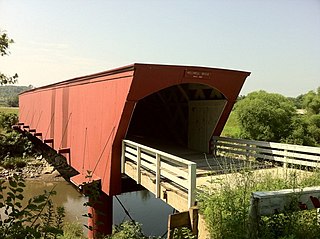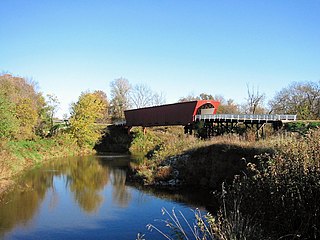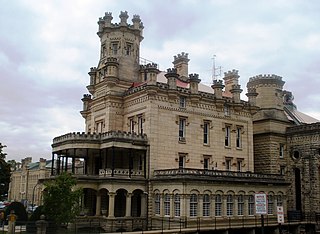Related Research Articles

Madison County is a county located in the U.S. state of Iowa. As of the 2020 census, the population was 16,548. The county seat is Winterset.

Bremer County is a county in the U.S. state of Iowa. As of the 2020 census, the population was 24,988. Its county seat is Waverly. The county was named for Fredrika Bremer, a Swedish feminist writer.

Winterset is a city in and the county seat of Madison County, Iowa, United States. The population was 5,190 at the 2010 census.

Winterset City Park is a public, city-owned park in Winterset, Iowa, United States. The first acres of land was bought on May 21, 1869, for cattle to graze on. In the 1950s, the land was converted into a city park. On March 10, 2021, Winterset City Park was placed on the National Register of Historic Places after it was nominated in 2020.

Cutler–Donahoe Bridge is a 79-foot-long (24 m) covered bridge in Madison County, Iowa. It was built in 1870 by Eli Cox. It originally crossed the North River near Bevington, Iowa. In 1979, the bridge was moved to its current location at the entrance to the Winterset City Park.

Holliwell Bridge is a wooden covered bridge in Madison County, Iowa. It was built over the Middle River in 1880 by Benton Jones.

The Madison County Courthouse is located in Winterset, Iowa, United States. It was listed on the National Register of Historic Places in 1981 as a part of the County Courthouses in Iowa Thematic Resource. It was included as a contributing property in the Winterset Courthouse Square Commercial Historic District in 2015. The courthouse is the third building the county has used for court functions and county administration.

The Roseman Covered Bridge is a historic covered bridge in Winterset, Iowa. It is prominently featured in the novel The Bridges of Madison County, as well as its film adaptation. It was built in 1883 over the Middle River, and renovated in 1992. The Roseman Covered Bridge was added to the National Register of Historic Places in 1976.

The Hogback Covered Bridge is a historic covered bridge near Winterset, Iowa. Named after a nearby limestone ridge, it was built in 1884 by Harvey P. Jones and George K. Foster over the North River on Douglas Township Road. The 106-foot-long (32 m) bridge was designed with a Town lattice truss system. It was built with steel pylons to support the main span.
Frank E. Wetherell (1869-1961) was an architect in the U.S. state of Iowa who worked during 1892–1931. He founded the second oldest architectural firm in the state in Des Moines, Iowa, in 1905. He worked with Roland Harrison in partnership Wetherell & Harrison. The firm designed numerous Masonic buildings.
George M. Kerns was an architect in Iowa.

William Foster was an architect in Iowa.

The William Ogburn House is a historic ruin located north of East Peru, Iowa, United States. This 1½-story limestone structure is an early example of a vernacular farm house, and the only known saltbox residence known to exist in Madison County. It is attributed to David Harris who used innovative design variations that were not used by other local masons. The stone of the main facade is composed of finished cut quarry faced stone laid two against one with broken bond within courses. The other elevations are composed of rubble limestone. It also features quoins and jambs of finished cut quarry faced stone. The house suffered a fire so only the stone walls remain. It was listed on the National Register of Historic Places in 1987.

The William R. and Martha Foster Shriver House is a historic residence located in Winterset, Iowa, United States. William R. Shriver was an Ohio native who settled in Jefferson County, Iowa before he moved to Madison County in 1853–54. He married Martha Foster in 1858 in Winterset. He was a wagon-maker by trade, and served as a lieutenant in the 1st Iowa Cavalry during the American Civil War. Shriver went into farming in the 1870s, and they left this house at that time. He went on to serve as the Clerk of District Court from 1882 to 1887. The Shrivers left Iowa for California in 1890 because of Martha's health. She died there that same year, and William returned to Iowa permanently in 1900.

The William Anzi Nichols House is a historic residence located east of Winterset, Iowa, United States. Nichols bought an 80 acres (32 ha) farm in 1855 and owned the land until he died in 1867. This house is an early example of a vernacular limestone farmhouse. The 1½-story structure is composed of locally quarried finished cut and rubble limestone. Its construction is attributed to David Harris who was known for laying the stones in a two against one broken bond. The house was listed on the National Register of Historic Places in 1987.

The McDonald House is a historic residence located west of Winterset, Iowa, United States. William and Barbara McDonald settled in Madison County during the Civil War, and bought this farm in the 1870s. Although not as early as others in the county, this house is a good example of a vernacular limestone farmhouse. This 1½-story structure is composed of locally quarried stone. Its construction is attributed to David Harris, who was one of the last stonemasons still working in the county when this was built. It follows an asymmetrical massed rectangular plan, and it is built on a slightly raised basement. It features two-against-one broken bond, and textured stone characteristic of Harris' work. The house was listed on the National Register of Historic Places in 1993.

The C.D. Bevington House and Stone Barn are historic buildings located in Winterset, Iowa, United States. Bevington was a pharmacist who passed through the area in 1849 on his way to the California Gold Rush. He settled in Winterset in 1853 after he made his fortune, and worked as a real estate agent and farmer. The house was built in the vernacular Gothic in 1856. The 2½-story brick structure features Gothic windows in the gable ends and carved bargeboards. The two porches were added around the turn of the 20th century. The two-story barn is composed of coursed rubble limestone. The lower level housed two horse stalls and stanchions for other livestock. A hay loft was on the upper level. The house and barn were listed on the National Register of Historic Places in 1976. Both buildings were donated to the Madison County Historical Society and are part of their museum complex.

The C.D. and Eliza Heath Bevington Privy is a historic building located in Winterset, Iowa, United States. Bevington was a pharmacist who passed through the area in 1849 on his way to the California Gold Rush. He settled in Winterset in 1853 after he made his fortune, and worked as a real estate agent, farmer, livestock dealer, and banker. The 7.5-by-10.33-foot structure is composed of roughly squared quarry faced rubble that is laid in a two against one bond. There is a stone vault with a depth of 6 feet (1.8 m) beneath the entire structure. The privy served the C.D. Bevington House. It was listed on the National Register of Historic Places in 1987. It is now part of a museum complex operated by the Madison County Historical Society.

Winterset Courthouse Square Commercial Historic District is a nationally recognized historic district located in Winterset, Iowa, United States. It was listed on the National Register of Historic Places in 2015. At the time of its nomination the district consisted of 82 resources, including 74 contributing buildings, seven noncontributing buildings, and one noncontributing object. The historic district covers most of the city's central business district in the original town plat. Most of the buildings are two-story, brick, commercial buildings. The commercial Italianate style is dominant, with Queen Anne, Romanesque Revival, and Neoclassical styles included. The Madison County Courthouse (1878) is a Renaissance Revival structure designed by Alfred H. Piquenard. Most of the buildings are brick construction, but four were constructed using locally quarried limestone. The stone buildings include the courthouse, the White, Munger and Company Store (1861), and the Sprague, Brown, and Knowlton Store (1866), all of which are individually listed on the National Register.

The Miles and Elizabeth Smith Kellogg House is a historic building located southwest of Winterset in rural Madison County, Iowa, United States. It was studied as part of the thematic resource, Legacy in Stone: The Settlement Era of Madison County, Iowa. The buildings in the study are located near extensive limestone deposits that were used by the early settlers of the county who possessed the financial means to build their houses and other buildings. Miles Kellogg bought a 160-acre (65 ha) farm from Oliver Smith and built this stone house, settling here in 1857. It is a variation of the split-level home that was realized on the exterior. It had a raised basement with the entrance to the main floor on the gable end and was a one-half flight above ground level. The main family entrance was a one-half flight below ground to the basement. The lower level, which contained a main family room-kitchen combination, was plastered the same as the main level, which was where the formal parlor was located. It also had a finished attic. The exterior was composed of rubblestone on the back and sidewalls and finished cut and quarry-faced stone on the main facade. The trim is simple. The house was listed on the National Register of Historic Places in 2017.